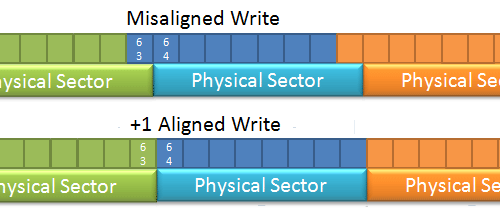
Will it break Windows XP compatibility?
Windows XP and other older OSes work by accessing specific disk sectors, not by using 'atomic writes' that work on byte-level data placements that we see in Windows Vista, 7, Server 2008, MacOS 10.4, 10.5 and 10.6 (Tiger, Leopard and Snow Leopard) and recent Linux kernels from 2.6.31 onwards.Windows XP (and Windows 2000 and Server 2003) use a method of accessing the hard disk that starts at sector 63. Because 4KB sectors match eight 512B sectors, sector 63 is unfortunately is one sector shy of being directly compatible, so using a 4KB data sector with these OSes causes mis-aligned writes.
The Western Digital EARS disk has the option (via a jumper on the back of the drive) to implement a hardware-level '+1' on every OS sector request. This means that if the OS requests Sector 63, the drive actually chooses Sector 64, and sector 1,090,203 from the OS becomes Sector 1,090,204 on the drive. This jumper-based workaround might not be the same for every 4K Advanced Format disk from every manufacturer, so check the manual and manufacturer’s website before you buy if you're using an older OS.

For those who want multiple partitions, for example those who dual-boot, things get a little more complicated as the old OSes do more convoluted things that the Western Digital drive’s firmware can't easily compensate for. When using partitions with a 4K Advanced Format disk on an OS that might have issues with it, WD has created an application to run in the background that will avoid the slow-downs that people have been reporting.


The 7-8 jumper (not supplied with the disk) has to be uses to enable XP compatibility mode. Click to enlarge.
Are there any other limitations?
Certain types of hard disk software needs to support the 4K Advanced Format - this includes cloning software and low-level formatting software. If you want to image your installation to a new disk, or completely wipe a 4K Advanced Format drive, then you need to check compatibility before use.RAID controllers are generally unaffected because they simply see stripe sizes and the disks as a whole – it’s the OS that directs where it thinks the reads and writes should be taken from. However, multiple partitions within RAID arrays might suffer the same consequences as above on sector-driven OSes, so again the background software might have to be used. Western Digital said that it cannot possibly test every setup for niche arrangements on older OSes, hence the ‘mights’ and ‘maybes.’
We asked about JBOD setups, and Western Digital claimed these only require the jumper workaround, as the whole drive is used as a single partition. That's good to know for the many people looking to upgrade Windows Home Servers (based on Windows Server 2003) with increasingly larger drives in the future.
What does the 4K Advanced Format do for me then?
Right now, not much. It's not a marketable feature that drive manufacturers are pushing and branding because there's currently little tangible benefit to the consumer. It simply eases the pressure on the fundamental data storage technique for hard disk manufacturers that will allow future platter capacity increases, which will then bring us benefits.However, we would like to see clearer labelling on 4K Advanced Format disks, as this could influence whether you buy the disk or not (perhaps you are still Windows XP, or plan to put the disk in a Windows Home Server). It’ll also help you to know to check that any storage software you plan to buy (cloning or deep-level formatting) is compatible with your new disk.

MSI MPG Velox 100R Chassis Review
October 14 2021 | 15:04








Want to comment? Please log in.